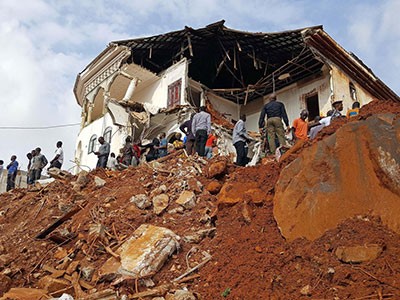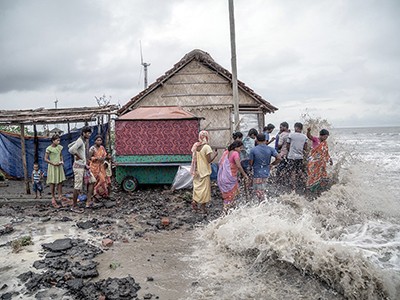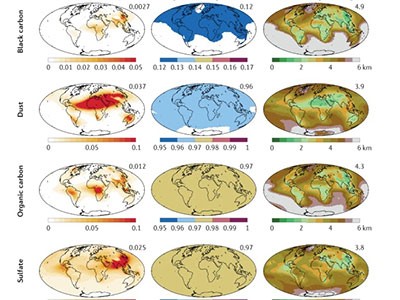When Pakistan faced appalling floods in June this year, global attention focused on climate change as the culprit. The country had three times the usual rainfall in its summer monsoon, exacerbated by short spikes of extremely heavy rain. Riverbanks burst and more than 1,600 people died. Formal attribution studies and politicians alike blamed global warming for making such an event much more likely. Something else should have been mentioned, too: aerosols.
Aerosols are the miasma of soot (black carbon), sulfur dioxide, organic carbon and other compounds that drives poor air quality over many of the world’s most-populated regions. Studies show that aerosols strongly affect the likelihood of extreme precipitation events1, such as those that contributed to Pakistan’s floods, and many other climate hazards.
Worse, it is not clear whether aerosols are set to rise, fall or stabilize. The amount of uncertainty about aerosol levels by 2050 is as large as the total increase since pre-industrial times (see ‘Drastic uncertainty’). Over the next 20–30 years, we might — or might not — see aerosol-driven climate changes as large as those that have played out over the past 170 years, adding as much as 0.5 °C to global warming. That could rapidly change the likelihood of extreme events occurring in many regions.
Yet the impacts of aerosols on climate risk are often ignored. The issue was not on the official agenda of the 27th United Nations climate conference (COP27) in Sharm-El-Shaikh, Egypt. This neglect must end.
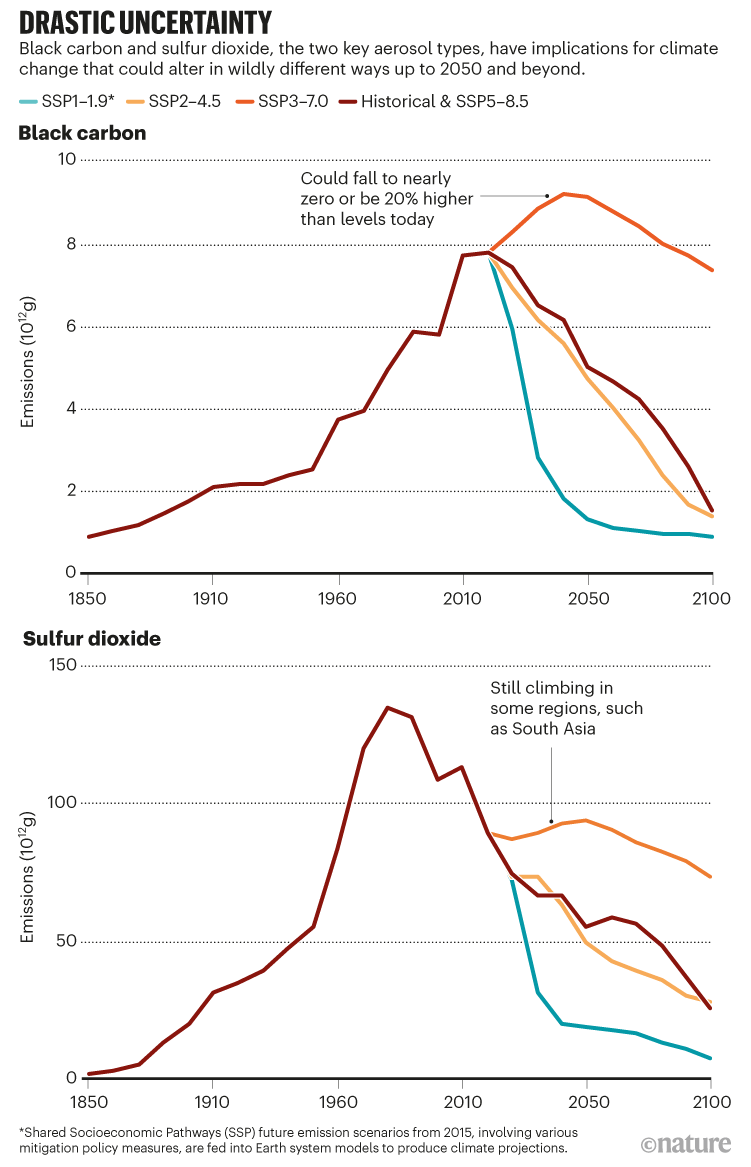
Source: Shared Socioeconomic Pathways database
Critical gap
Aerosols are hugely important to the climate, globally and regionally. The details are complicated. Some aerosols warm the atmosphere, others cool it, depending on their type, height above ground and impact on clouds. But, overall, vast emissions of aerosols since the start of the industrial age have had a profound cooling effect by reflecting sunlight. Without them, the global warming we see today would be 30–50% greater.
Historically, aerosols have had dramatic regional impacts. They were the main reason temperatures in Europe didn’t warm between the 1950s and 1980s2. They drove a decline in the South Asian monsoon during the second half of the last century3. And they were a major driver of the late-twentieth-century Sahel drought4, which triggered a famine that killed 100,000 people.
How climate change and unplanned urban sprawl bring more landslides
Globally, aerosols are a more powerful player in climate extremes than are greenhouse gases. Warm the world by removing aerosol emissions and this will create more extremely hot days, more extreme precipitation events, and more consecutive dry days over highly populated regions, than if the world was warmed by the same amount by adding greenhouse gases5.
Despite all this, regional estimates of risk from climate change often omit aerosol impacts. Most evaluations of near-term climate risk used by policymakers either ignore aerosols or reduce their effects to a globally averaged offset to warming by greenhouse gases. This probably strongly underestimates risks to communities both near and far from sources of aerosols.
As experts in aerosol–climate interaction, climate impacts and scenario development from many nations, we call for estimates of climate risk to include regional aerosol projections. Policymakers and stakeholders must recognize that their assessments of near-term risk are probably missing a critical component. In the longer term, we need to ensure that any forecasting tools used are ‘aerosol aware’.
Stakeholders potentially face a range of nasty surprises if they continue to be solely focused on risks driven by greenhouse gases.
Deep impact
When it comes to climate risk, aerosols are wickedly more complicated than are greenhouse gases.
Aerosols last for days to weeks. Their effects show up and change much more quickly than do those of greenhouse gases, which last for decades to centuries. Aerosols, unlike greenhouse gases, tend to stay near where they’re emitted, concentrating impacts over heavily populated, industrial regions. Farther away, aerosols are felt through their effects on atmospheric circulation, with patterns that can differ markedly from those of greenhouse gases and that don’t always add up linearly6.
The impacts of aerosols can be very different depending on their source. Over Western Europe, for example, they might cool the planet by anywhere from 3 to 14 times more than might the same quantity and type emitted from India7,8.
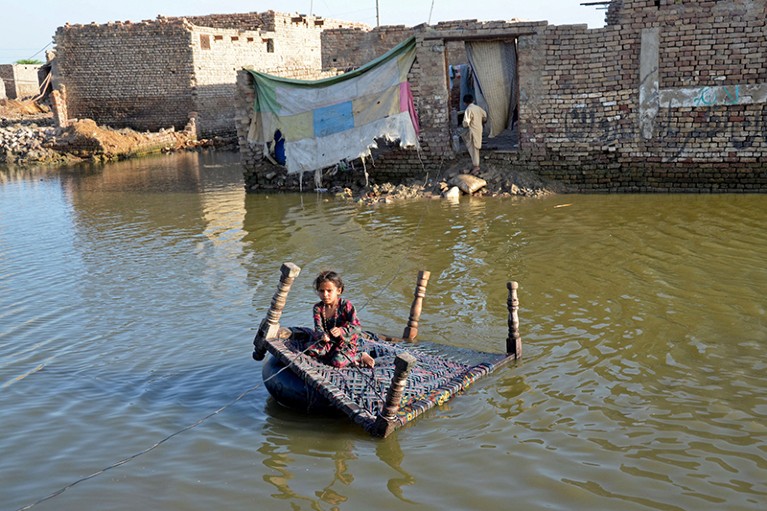
This year’s torrential monsoon rainfall caused devastating floods in Pakistan.Credit: Fida Hussain/AFP via Getty
From the 1850s onwards, global aerosol emissions skyrocketed in lockstep with industrialization. In the 1970s and 1980s, concerns about the public-health impacts of air pollution led to landmark policy measures, which mainly brought down aerosol emissions in Europe and the United States. A similar turnaround is now playing out in China. But in South Asia, for example, sulfate emissions are still climbing. And aerosols in many low- and middle-income countries, including most of Africa and southeast Asia, are projected to increase with industrialization.
The future of aerosol emissions is highly uncertain, because it depends on difficult-to-predict trends in technology and policy. Black-carbon emissions, for example, could be 20% higher than those today by 2050, or they could plummet to nearly zero (see ‘Drastic uncertainty’).
Evolving aerosol emissions will be a major driver of climate change throughout the coming, critical decades of mitigation and adaptation. They need to be accounted for.
Blind spot
Climate researchers have made great strides in understanding how aerosols affect the weather, and in quantifying these impacts and integrating this into Earth system models. There are still knowledge gaps, particularly around clouds, and it is important that these be plugged. But, overall, these complex global models represent aerosols’ impacts fairly well, which is how we know of their outsized influence on the climate so far. These global Earth system models produce a comprehensive view of future climate change, including that due to changes in regional aerosol emissions.
But when policymakers turn to consultancy companies, non-governmental organizations (NGOs) or even reports from the Intergovernmental Panel on Climate Change (IPCC), seeking assessments of climate-change risk, the impact of aerosols is often lost along the way.
Climate simulations: recognize the ‘hot model’ problem
Regional-to-local assessments of climate risk often use versions of complex Earth-system-model projections that have had their spatial resolution increased using higher-resolution regional climate models or statistical algorithms. The results can then be fed into a model of a region’s water supply, or used to design a resilience plan for one city. But most regional climate models do not include aerosol processes. And statistical algorithms assume that historical relationships will persist into the future, even though, for many regions, aerosol emissions and impacts are changing rapidly.
Meanwhile, broader climate risk assessments, such as those for insurance rates or policy cost–benefit analyses, might use complex Earth-system-model projections to tune simpler climate model or statistical emulators that can efficiently recreate the behaviour of the more complex models. These simple models can rapidly generate hundreds of scenarios to produce estimates of social cost. But such simplified approaches often retain information only on global-mean temperature, and ignore how aerosols can drive damaging extreme events in specific regions.
In other words, near-term estimates of climate risk usually consider only risks driven by greenhouse gases. As a result, they are probably wrong for many regions. This is, unfortunately, particularly true for densely populated regions with vulnerable populations, including southern and southeast Asia and sub-Saharan and West Africa. These regions are at risk both from their own rapidly changing aerosols and, in the case of southern Asia and the Sahel, because they bear the brunt of the long-range effects of past aerosol changes in Europe and North America.
Many of us will be working to quantify comprehensive regional impacts of future aerosol changes through the new Regional Aerosol Model Intercomparison Project (RAMIP; see go.nature.com/3gl1jvn). But there is already evidence that ongoing aerosol reductions are reversing past trends in the South Asian summer monsoon and increasing local flood risk9. Aggressive aerosol reductions could double the increase in heat extremes over China and Europe by 2050, in contrast to the slower reductions required by current legislation10.
Feedback loop
The silence on aerosols that we set out here has become self-fulfilling. Because the current toolkit is largely blind to this climate risk, much of the community has come to view aerosols as largely unimportant. This has limited the sophistication, realism and range of risk modelling that is ‘aerosol aware’.
The result is an underappreciation of the role of aerosols in policy. The IPCC Sixth Assessment Report, for example, relies mainly on the pattern of climate effects from warming driven by greenhouse gases when quantifying “climate impact drivers” (this report is the summary of physical climate responses mainly used by the impact and risk communities).
Scattering and absorbing aerosols in the climate system
Similarly, the World Weather Attribution project, which does invaluable rapid analyses of the impacts of climate change on severe weather events such as the Pakistan flood, does not yet include aerosols in its protocol for attribution. This is partly because the existing regional-climate-model simulations used do not isolate the effect of aerosols.
Some regional-scale emulators capable of capturing climate responses to regional aerosol changes are being developed. But they are in their infancy and require more investment and buy-in. Efforts such as RAMIP will help to increase the information needed to train these ‘aerosol-aware’ emulators. In the meantime, climate-impact researchers and climate service providers who rely on emulators are probably unaware of whether or not these include regional aerosol effects, much less that they should demand their inclusion.
Of course, all of these models are only as good as the data they ingest. The aerosol-emission inventories that are fed into Earth system models are often coarse in space and time, creating uncertainty. In fact, a 2021 study showed that the version of this inventory that was used for the latest IPCC report markedly underestimates trends in aerosol emissions in China over the past 5–10 years (and, consequently, whether recent changes in these aerosols are causing cooling or warming)11.
Such mistakes or lags in data are less critical when modelling risks of carbon dioxide, because those depend on cumulative concentrations resulting from decades to centuries of emissions. If policymakers, funders and researchers recognized the importance of aerosols, there would be much greater investment in keeping these inventories accurate.
Researchers need to continue to improve our fundamental understanding of how aerosols will influence regional climate change and climate impacts. Estimates of aerosol emissions in the past and projections of how they might change in the future need to be refined. Consultants and NGOs must invest in and adopt new ‘aerosol aware’ methods of estimating climate risk. Funding agencies, foundations, universities and national laboratories must prioritize collaboration to better determine the impacts of aerosols on climate risk. Policymakers must recognize that changing regional aerosol emissions are transforming the landscape of climate risk and should demand projections that account for that.


